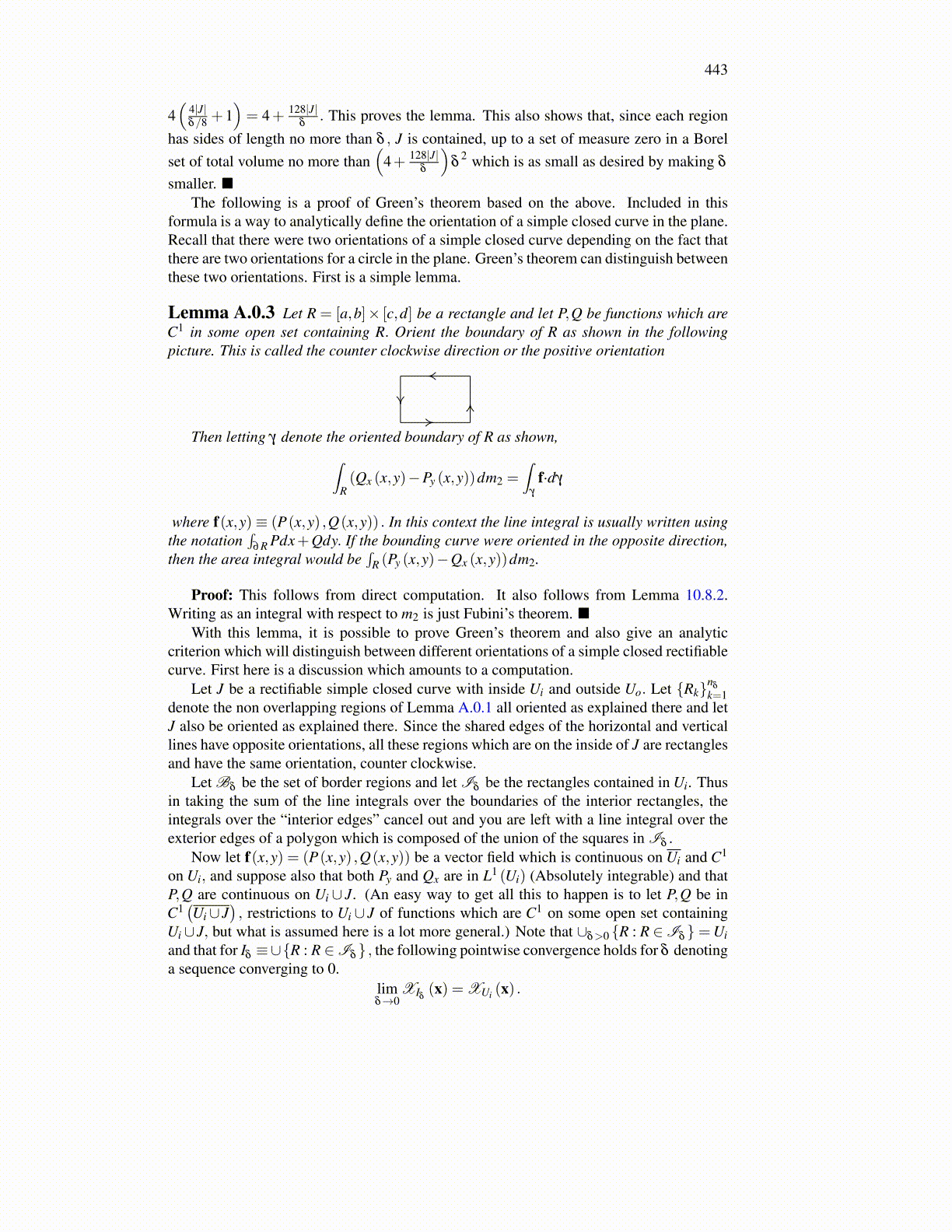
443
4(
4|J|δ/8 +1
)= 4+ 128|J|
δ. This proves the lemma. This also shows that, since each region
has sides of length no more than δ , J is contained, up to a set of measure zero in a Borelset of total volume no more than
(4+ 128|J|
δ
)δ
2 which is as small as desired by making δ
smaller. ■The following is a proof of Green’s theorem based on the above. Included in this
formula is a way to analytically define the orientation of a simple closed curve in the plane.Recall that there were two orientations of a simple closed curve depending on the fact thatthere are two orientations for a circle in the plane. Green’s theorem can distinguish betweenthese two orientations. First is a simple lemma.
Lemma A.0.3 Let R = [a,b]× [c,d] be a rectangle and let P,Q be functions which areC1 in some open set containing R. Orient the boundary of R as shown in the followingpicture. This is called the counter clockwise direction or the positive orientation
Then letting γ denote the oriented boundary of R as shown,∫R(Qx (x,y)−Py (x,y))dm2 =
∫γ
f·dγ
where f(x,y)≡ (P(x,y) ,Q(x,y)) . In this context the line integral is usually written usingthe notation
∫∂R Pdx+Qdy. If the bounding curve were oriented in the opposite direction,
then the area integral would be∫
R (Py (x,y)−Qx (x,y))dm2.
Proof: This follows from direct computation. It also follows from Lemma 10.8.2.Writing as an integral with respect to m2 is just Fubini’s theorem. ■
With this lemma, it is possible to prove Green’s theorem and also give an analyticcriterion which will distinguish between different orientations of a simple closed rectifiablecurve. First here is a discussion which amounts to a computation.
Let J be a rectifiable simple closed curve with inside Ui and outside Uo. Let {Rk}nδ
k=1denote the non overlapping regions of Lemma A.0.1 all oriented as explained there and letJ also be oriented as explained there. Since the shared edges of the horizontal and verticallines have opposite orientations, all these regions which are on the inside of J are rectanglesand have the same orientation, counter clockwise.
Let Bδ be the set of border regions and let Iδ be the rectangles contained in Ui. Thusin taking the sum of the line integrals over the boundaries of the interior rectangles, theintegrals over the “interior edges” cancel out and you are left with a line integral over theexterior edges of a polygon which is composed of the union of the squares in Iδ .
Now let f(x,y) = (P(x,y) ,Q(x,y)) be a vector field which is continuous on Ui and C1
on Ui, and suppose also that both Py and Qx are in L1 (Ui) (Absolutely integrable) and thatP,Q are continuous on Ui ∪ J. (An easy way to get all this to happen is to let P,Q be inC1(Ui∪ J
), restrictions to Ui ∪ J of functions which are C1 on some open set containing
Ui∪ J, but what is assumed here is a lot more general.) Note that ∪δ>0 {R : R ∈Iδ}=Uiand that for Iδ ≡∪{R : R ∈Iδ} , the following pointwise convergence holds for δ denotinga sequence converging to 0.
limδ→0
XIδ (x) = XUi (x) .